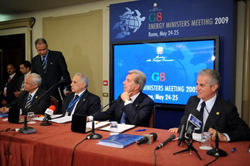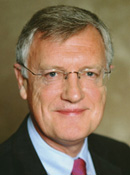Climate change: regulators claim their part
on
Climate change: regulators claim their part
Energy regulators want to play their part in the fight against climate change. They have many instruments at their disposal to promote energy efficiency and the use of renewables. But in the end it is governments that have to give them the necessary powers.
 |
| The G8 energy ministers meeting in Rome, May 2009 |
| Article Highlights: |
| - Energy regulators from across the globe have committed themselves to do their part in creating “climate-responsible” markets |
| - That was the most important upshot from the World Forum on Energy Regulation held recently in Athens. |
| - The Forum showed that there are many concrete steps regulators can take to help lower emissions, improve energy efficiency and promote the use of renewable energy. |
|
- In the end, however, to do this job properly, they need to be given the necessary powers from their governments. |
One of the new ICER’s four working groups will be dedicated to defining the energy regulators’ role in tackling climate change. ‘For the first time, energy regulators from across the globe have jointly committed to play their role in overseeing efficient and climate responsible markets,’ said John Mogg, the Chair of the new organisation and President of the Council of European Energy Regulators (CEER).
Climate change was officially made an issue for the regulators at the last meeting of G8 energy ministers in Rome on 24-25 May 2009, when the G8’s Italian Presidency invited the Italian energy regulator to organise a Round Table of Energy Regulators. This round table produced a ‘G8 + Energy Regulators Statement’, containing its views on ‘how to achieve a new form of world energy governance’.
Here, for the first time, energy regulators confirmed their role in, among other things, ‘reduction of greenhouse gas emissions by promoting affordable and accessible clean energy technologies and a shift towards cleaner fuels’, as well as more generally in helping to create ‘energy markets that can contribute to the reduction of greenhouse gas emissions’.
As the meeting in Athens made clear, fighting climate change is a task most energy regulators are happy to take on. For Finn Dehlbaek, Deputy Director of the Danish Energy Regulation Authority, the role of regulators in this regard is ‘crucial’. Regulators, he indicates, have many ways to ease the transition towards low-carbon energy markets. They can:
- provide economic incentives to transmission system operators (TSOs) to reduce power grid losses
- improve customers’ awareness of energy prices and green energy
- promote investments in new infrastructure
- promote investment in smart grids and the use of smart meters
- secure a predictable regulatory environment to boost investment.
Burden on consumers
In the transition towards a low-carbon economy, the role of energy networks is generally regarded as crucial. Until recently, energy flows in the electricity networks were fairly stable, with conventional sources dominating and little intermittent supply from renewable sources. Demand, too, was fairly stable, with consumers having little incentive to adjust their energy consumption, as their bills were based on good old meters that were read once a year.
Today, all of that is changing. The liberalisation of energy markets has sped up the transformation of electrical networks so that they serve multiple generators and no longer just national or regional monopolies. Interconnections nowadays serve crossborder trade more than system security. On top of that, politicians have promoted the development of renewable sources of energy and more energy efficiency. As a result of these developments, the networks need to be made “smart” through the introduction of new information and communication technologies (ICT). According to the regulators’ statement at the G8 meeting, “smart grids” have the potential to allow for quicker response to demand, making retail and wholesale markets more competitive, enabling a higher penetration of renewable generation and reduced losses.
| It is the regulators who will have to find some middle ground between the public’s demand for low tariffs and the need for new investments in advanced networks |
Regulators in the US face the same challenge. ‘As US climate change policy takes shape’, says Rick Morgan, Commissioner at the US state regulator for the District of Columbia, ‘utility regulators at the state level have vital roles to play: most importantly, to work with Congress to ensure appropriate measures to limit carbon emissions while minimising economic impacts on consumers.’
The regulators, as arbiters of the collective interest, are therefore seen as key players in ensuring the most efficient investments, as Australian regulator John Tamblyn confirms. ‘Changes to the design of energy markets can help minimise transition costs – and this should be a key focus for energy market rule-makers and regulators.’
Selling savings
In Athens, a number of concrete measures were discussed that regulators can take to support their governments’ climate change policies. For example, as Martin Crouch from UK energy regulator Ofgem pointed out, regulators can try to change the structure of trading markets, especially by moving from a traditional day-ahead electricity bidding system to one in real time. As renewables such as wind energy are intermittent sources of energy, renewable suppliers cannot very well forecast their future generation. A real time bidding system, or one that allows last minute changes to bids as in the UK, helps renewables compete against fossil fuel suppliers.
Richard Cowart, Director of European programmes for the Regulatory Assistance Project and former regulator of Vermont State in the US, called attention to an innovation that is being tested by three regulators in the northeastern US called ‘demand response’ or ‘demand-side bidding’. This allows energy retailers to sell energy savings back into the electricity market. By aggregating their client base, retailers can manage their overall demand and feed this back into the market to help balance the grid, the same way as generators do with their generation capacity. The retailers are said to sell ‘negawatts’ (withdrawn demand) rather than Megawatts.
| Regulatory refrom should make it possible for utilities to make more profits when their customers use less energy |
And there are other things regulators can do:
- support energy efficiency transformation programmes
- promote tariff structures that provide incentives for the implementation of efficiency programmes
- implement energy efficiency performance standards
- and support initiatives that encourage consumers to keep their energy bills under control through more efficient energy use.
Richard Cowart even went a step further. He said that regulatory reform should lead to a change in the current, 100-year-old business model, whereby a utility that sells more energy, makes more money. According to Cowart, this should be replaced with a system in which energy utilities make more profits when its customers save on their energy use. Such a radical change could not be effected by energy regulators alone of course. This would ultimately be a political decision. Recognising this, Walt Patterson, associate fellow in energy, environment and development at Chatham House, London, argued that regulators should take the lead in speaking to governments. They should advocate a rule change that would see energy companies profit from upgrading user technology and infrastructure, said Patterson.
 |
|
Sir John Mogg, President CEER |
The first task of the new ICER working group on climate change will now be to draft a report on best regulatory practices in the promotion of energy efficiency for the next meeting of G8 energy ministers in 2010. The report will take account of differences in market structures, operational models and stages of development. This stage is essential because it will allow regulators to exchange their experiences and apply them in their own countries. For as long as the powers of regulators vary from one country to the other, their role in fighting climate change will vary too.


Discussion (0 comments)